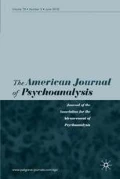References
Benedict, R.: Patterns of Culture. New York: Pelican Books, 1946.
Engels, F.: Origin of the Family, Private Property and the State. Chicago: Kerr, 1902.
White, L.: The Evolution of Culture. New York: McGraw-Hill, 1959.
Kardiner, A.: The Individual and His Society. New York: Col. Univ. Press, 1939.
Haydu, G. G.: The Architecture of Sanity. New York: Julian Press, 1958.
Movius, H. L., Jr.: Radio Carbon Dates Palaeolithic Archaeology. Current Anthropology, 1: 355, 1960.
Barzun, J.: Romanticism and the Modern Ego. Boston: Little Brown, 1943.
Borgese, G. A.: Romanticism, in Encyclopedia of the Social Sciences, Volume XIII: 426. New York: Mac-Millan, 1930.
Rousseau, J.-J.: Confessions. London: Dent, 1931.
Rousseau, J.-J.: Correspondance Générale, Vols. 1–20. Paris: Colin, 1924–34.
Federn, P.: Ego Psychology and the Psychoses. New York: Basic Books, 1952.
Schilder, P.: Selbstbewusstsein und Personlichkeitsbewusstsein. Berlin: Springer, 1914.
Nunberg, H.: The Synthetic Function of the Ego, in Practice and Theory of Psychoanalysis. New York: Nervous and Mental Diseases Publications, 1948.
Stern, W.: General Psychology from the Personalistic Standpoint. New York: MacMillan, 1938.
French, T. M.: The Integration of Behavior. Chicago: University of Chicago Press, 1954.
Kelman, H.: Evolution of the Horney Theory. Amer. J. Psychoan., 11: 89, 1951.
Goldstein, K.: The Organism. New York: American Books, 1939.
Murphy, G.: Personality: a Biosocial Approach to Origins and Structures. New York: Harper, 1947.
Ericson, E. H.: The Problem of Ego-Identity. J. of Amer. Psycho-Analytic Assn., 4: 56, 1956.
Angyal, A.: Foundations for a Science of Personality. New York: The Commonwealth Fund, 1941.
Pavlov, I. P.: Conditioned Reflexes. New York: Oxford Univ. Press, 1927.
Grinker, R. R., (Ed.): Toward a Unified Theory of Human Behavior. New York: Basic Books, 1956.
Miller, J. G.: Living Systems: Basic Concepts. Behavioral Science, 10(3): 193–237, 1965.
Haydu, G. G.: Manic-Depressive Rhythm: Its Pharmacological Modification and the Nature of the Self Structure. Annals of the N.Y. Acad. of Sci. 98: 1126, 1962.
Sullivan, H. S.: Conceptions of Modern Psychiatry. New York: Lawton, 1947.
Malinowski, B.: Freedom and Civilization. New York: Roy Publishers, 1944.
Bleuler, E.: Dementia Praecox or the Group of Schizophrenias. New York: Int'l. Univ. Press (1911), 1950.
Hoch, P. H. and Catell, J. P.: The Diagnosis of Pseudoneurotic Schizophrenia. Psych. Quart. 33: 17, 1959.
Rousseau, J.-J.: Reveries of a Solitary. London: Southworth, 1927.
Author information
Authors and Affiliations
Additional information
author ofThe Architecture of Sanity (New York: Julian Press, 1958).
Rousseau is seen as composed of several unintegrated need-complexes. In 1750 his view, actions and style became unified for awhile: the first full-fledged Romantic Idiom. It became a powerful catalyst of Wetsern Culture. A new pattern of culture, it is suggested here, is not a lucky find, or a carefully reasoned out scheme, or an automatic next phase. Rather, it is a pattern of view and action, which is gained through interrelated integrative transformations. (Editor)
Rights and permissions
About this article
Cite this article
Haydu, G.G. Interrelated transformations of Rousseau's life and of western culture of his time. Am J Psychoanal 30, 161–168 (1970). https://doi.org/10.1007/BF01874039
Issue Date:
DOI: https://doi.org/10.1007/BF01874039

